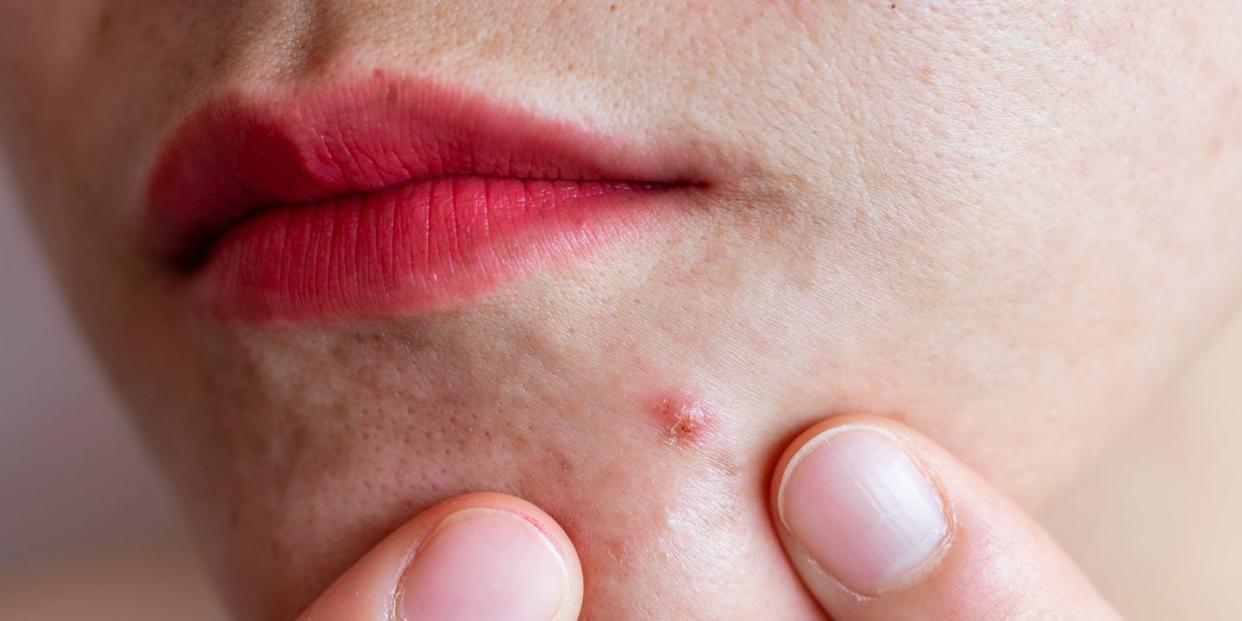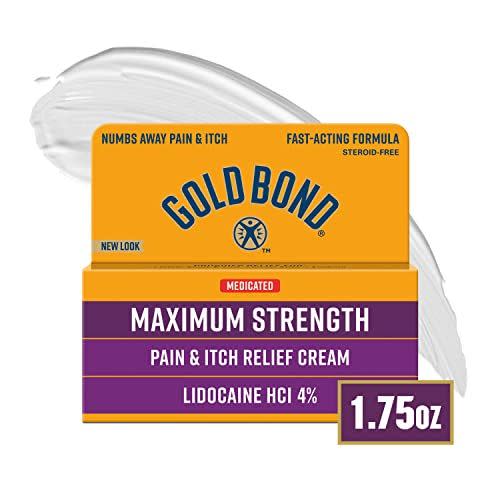If Your Breakouts Are Painful And Persistent, You Might Have Nodular Acne

"Hearst Magazines and Yahoo may earn commission or revenue on some items through the links below."
You’ve probably come across a few different types of acne in your day (we’re looking at you blackheads), but some pimples can be extremely large, painful, and very persistent. If your pimples aren't budging despite endless cleansing, at-home remedies, and spot treatments, you may have nodular acne.
Meet Our Experts: Lian Mack, MD, a dermatologist and the founder of GlamDerm in New York City, Vladyslava Doktor, DO, a dermatologist and the owner of Skin Center Boston
“Other acne is typically caused by simple blockage of the skin, but nodular acne is more of a mixture of hormones and bacteria that makes it very severe,” says Vladyslava Doktor, DO, a dermatologist and the owner of Skin Center Boston. It also involves a bacteria called p. acne which causes an infection when trapped in your pores and leads to deep, uncomfortable breakouts, she explains.
While difficult, nodular acne can be treated, and it’s important to talk with your doctor to find the right plan for you. Read ahead for everything you need to know about nodular acne in the meantime.
What Is Nodular Acne?
“Nodular acne, also known as nodulocystic acne, is a subtype of acne characterized clinically by pink firm bumps that develop beneath the skin,” says Lian Mack, MD, a dermatologist and the founder of GlamDerm in New York City. It can be caused by several factors including hormones, diet, and stress, but acne nodules result from bacteria, combined with dead skin cells, sebum (oil), and a clogged pore that together create an inflammatory response, she explains.
Most commonly showing up on the face, back, or chest, nodular acne breakouts are typically painful to touch and cause hard lumps, knots, or mounds under the skin, says Dr. Doktor. “[The nodules] are red and angry looking, almost like a mini volcano that doesn't want to erupt,” she explains. The firm bumps also remain under the skin and do not have a whitehead or blackhead at the center, adds Dr. Mack.
This type of acne also tends to be resistant to topical medications and can persist for months. So if none of your over-the-counter spot treatments or beauty products seem to be clearing away the blemishes, that may be another red flag of nodular acne, adds Dr. Mack.
What Causes Nodular Acne?
Anyone can get nodular acne and every case is different, but it can typically be caused by hormones and diet or the presence of bacteria, dead skin cells, and sebum (oil) in pores, says Dr. Mack.
“Nodular acne resulting from hormones would typically appear on the lower half of the face, along the chin and jawline, and would typically sync up with your monthly cycle, whereas nodular acne stemming from bacteria could appear anywhere, anytime,” she explains.
Nodular acne can also occur due to excessive sweating, stress and anxiety, skincare products, medication, birth control, or genetics, adds Dr. Doktor. In other words, there's not a single culprit responsible, and it’s important to evaluate the cause holistically because it’s “multi-factorial,” she explains.
How To Treat Nodular Acne
Over-the-counter treatments aren't usually effective, so if your breakouts are painful, persistent, and/or taking a toll on your mental health and confidence, it’s best to visit a dermatologist ASAP, says Dr. Doktor. Plus, treatment is not a one-size-fits-all type of deal, so what works for your friend may not work for you. “Treatment is not one recipe, and I always try to approach it from different angles because it depends on the person's background,” Dr. Doktor adds.
Pro tip: If you've tried an OTC skincare regimen for 6 to 8 weeks and continue to develop cystic breakouts, then it’s time to seek help from a professional, says Dr. Mack.
If your acne is hormonally driven, Dr. Mack recommends the following:
Vitamin A derivative: The treatment regimen for hormonally driven acne usually includes a vitamin A derivative like tretinoin to reduce oil production and speed up skin cell turnover.
Prescription topicals: Stronger, prescribed, topical medications can lessen the effect of hormones of the sebaceous glands and minimize painful breakouts.
Oral medications: Depending on the severity, oral medications like spironolactone or oral contraceptives (containing estrogen and progesterone) can help cut down the amount of free testosterone in the blood, reducing the sebum production on the lower half of the face.
Diet modifications: Always consult with your doctor, but diet can negatively impact nodular and/or hormonal acne. In particular, studies suggest dairy and refined sugar have been shown to exacerbate symptoms and cause inflammation, so an elimination diet may be beneficial.
If your acne is caused by excess oil production, bacteria, and dead skin cells, the following are Dr. Mack’s go-to’s:
Topical pain relief: If your lesions are painful, Dr. Mack suggests Gold Bond’s Medicated Pain and Itch Cream with Lidocaine to help with tenderness. It’s non-irritating, non-greasy, and fast-acting.
Oral medications: Like hormonally caused nodular acne, prescribed oral medications like isotretinoin (previously known as Accutane) or antibiotics can reduce sebum production, prevent clogged pores, decrease bacteria, and minimize inflammation.
Topical retinoid: Topical treatments such as retinoids can squash breakouts by preventing dead cells from clogging pores and promoting cellular turnover.
Cortisone injections: If your nodules are extremely painful, your doc may suggest a cortisone injection to bring down inflammation and speed up the healing process.

Lidocaine Multi-Symptom Relief Cream
amazon.com
$7.46
amazon.comIt may be tempting to treat nodular acne on your own, but here’s what you shouldn't do:
Do not pick. I repeat, do NOT pick, squeeze, or mess with your acne. “This will worsen scarring and can actually create another acne-like condition called acne excoriée, which is when lesions are compulsively squeezed and scratched, resulting in scabs and scars,” says Dr. Mack. Not to mention, the scarring that results from nodular acne is often more difficult to treat than the actual breakout, she adds.
Avoid touching your face. To reduce adding additional bacteria to the skin, keep your hands off your face. If you need to touch, make sure your hands (and makeup brushes!) are clean, says Dr. Mack.
Don’t go overboard on products. Your skincare routine is important, but keep it basic and oil-free. Even if your products are “anti-acne,” too much may cause an angry response and irritation to the skin, says Dr. Doktor. “Keep the cleansing and moisturizer as simple and as less irritating as possible, so over-the-counter cleansers should be hydrating and gentle like CeraVe, La Roche-Posay, and Cetaphil.”
You Might Also Like

